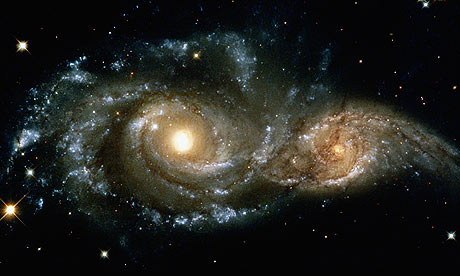A galaxy of helpful people
A galaxy of helpful people
由一群热心人组成的星系
作者:Suw Charman-Anderson
日期:2009 年 1 月 15 日
概要:一位牛津大学科学家利用互联网的威力来创造出一个公众共同参与的科学项目。
当 Chris Lintott 博士,一位牛津大学物理系的研究人员,开始考虑创建一个利用公众的力量帮助为一百万个星系处理分类的网站时,他估计需要 3 到 4 年的时间来完成。星系动物园(网址:galaxyzoo.org),创立于 2007 年 7 月,一个一开始被认为前景黯淡的项目,现在成为了互联网上最大的公众科学实验项目。
星系可以分为旋涡星系,椭圆星系和碰撞中的星系(即当它们交汇的时候)。SDSS(网址:sdss.org),一个数字化的宇宙研究项目,拥有接近 100 万张的星系图片,这些原始的数据需要处理分析,以确定这些星系的类型。
Linton 博士希望每张图像都能得到十次的分类点击,而且公众能被证明有能力依据星系的特点来给它们分类。三周过去了,超过了 1000 万的点击率,他被证明是正确的:公众们完全有能力像专业的天文学家那样给它们分类,甚至分类得更好,并且,速度也很迅速。“那种感觉就像被被海啸撞击。”Linton 博士说。
现在那些图像的点击总数已经超过了 7000 万,这允许 Lintott 和他的队伍更加轻松简单地把各种星系归类为旋涡星系,椭圆星系和碰撞中的星系,并进行更深入的研究。“你完全可以放心,就像我们所说的,如果 100% 的人都说它是一个螺旋星系,那它肯定就是螺旋星系了。”Lintott 说到。
人类的动物园
他的队伍最近被分配到位于西班牙南部的 IRAM 的 30 米口径射电望远镜,并且轻易地从图像样本中选出 40 个星系来研究,获得科学家们真正需要的可靠的资料。
在星系动物园获得初步成功后,Lintott 希望能更深入地观察碰撞中的星系。在星期二下午 5 点钟,他把一份列出他选择的讨论问题的电子表格发给他的小组成员,叫他们看一看哪个话题是最好的,然后发电子邮件给他。接着他去了酒吧。
Richard Proctor,追随者之一,是一位电信顾问,他看了表格后想“我可以弄一个网页来做这个啊!”当 Lintott 回来的时候,这个网页已经在运行了。
当一个小小的研究转变为一个研究45000张图像的大研究项目时,Protor 说,每张图片现在已经拥有超过 25 次的点击(这意味着至少被辨认了 25 次),每一张都拥有 4 个特别兢兢业业的心灵在观察着。关于交汇星系的第一份学术论文已经呈送,Proctor 被列入合编人员的名单。
这并不是第一次天文学通过互联网来进行合作研究了。在 1999 年 5 月,一个寻找外星文明生物的工程(缩写为 SETI ) ,把最强大的分布式计算机运算能力应用到它的 SETI@home 软件中。这个软件利用空闲的家用计算机的计算能力来运算从特定波长上收集的数据,来观察是否有外星文明在尝试与我们沟通。这个程序被 520 万人使用,最高能提供每秒 265 Tfop 的数据处理能力。
Similarly, Nasa's Clickworkers project in 2000-01, found that ordinary people were just as good as astronomers at identifying craters on Mars in photos. 类似的,2001年1月,美国航空航天局的“Clickworkers”项目,发现普通人在分辨火星图片上的坑状物的能力方面,和天文学家们不相上下。
The biggest influence on Galaxy Zoo, however, is Stardust@home, where users search for tiny interstellar dust particles within images returned by the 2006 Stardust mission. Thousands of users have logged on to the site. “星系公园”的最大灵感则来自Stardust@home(意思是在家寻找星尘),使用者通过“2006星尘任务”返回的图像来寻找行星间的尘埃。成千上万的人已经参与其中。
"Stardust@home was a real inspiration for us," says Lintott. "We thought, 'If 20,000 people will look for dust grains in their spare time, surely they will look at beautiful pictures of galaxies?'" “Stardust@home的确是我们的一个灵感”,Lintott说。“我们猜想,如果两万人能在他们的空闲时间寻找星尘颗粒,他们肯定愿意观看美丽的星系的图像。”
But unlike those projects, where the task is set from the top down, the Galaxy Zoo community has its own ideas about what can be done with the SDSS data.
不过和一些其它的一些计划不同,星系动物园组织拥有他们自己的想法,他们知道能从SDSS的数据中得到什么。
"Up until now," says Proctor, "the professional astronomers have come up with things that want classifying and we've classified them." But there are thousands of irregular galaxies - neither spiral nor elliptical - that the professionals don't have time to examine. So the community decided to do it themselves, drafting a list of questions and building a web interface to make classification easier. “直到现在,”Proctor说,“天文学专家提出了一些他们想被归类的东西,而我们把这些东西归类好了。”不过不规则的星系成千上万,既不是螺旋星系,也不是椭圆星系,那些专家们没有时间去检验,所以我们的组织决定自己来做这些工作,起草,列出问题,并建立一家网站来令分类起来更加容易。
"Once we've got some results," promises Proctor, "we'll publish them for everybody to use, and then see if we can find out anything useful. Given that the biggest study of irregular galaxies to date looked at around 150, and we've got 9,000, we must find something!" “一旦我们得到结果,”Proctor许诺,“我们将会提供给每一个人,然后看看我们能不能发现一些有用的东西。我们大约有9000组不规则星系的数据,现在大约观察到第150组,我们必须发现一些东西!”
Lintott is supportive of the irregulars project: "They are doing everything professional astronomers would do," he says. "It's up there with any work I've done." Lintott很支持这项研究不规则星系的工作:“他们在做一切天文学专家会做的事情,”他说:“我会做的都在那里了。”
It's not just the volume of research that can be done by collaborating with the public that's important to Lintott, but also the opening up of scientific research to anyone with a browser and a little time. 对Lintott来说,重要的不仅是公众通力合作所能产生的巨大的研究量,科学研究向一切拥有一个浏览器和一点空闲时间的人敞开大门同样重要。
"By making the data available to everyone," he says, "whatever stage you are in your learning, you can do research." “通过向每一个人提供可用的数据,”他说:“无论你处于哪一个学习阶段,你都可以参与研究。”
And a surprising cross-section of people are doing just that. Hanny van Arkel is a Dutch primary school teacher who discovered a strange object, now called Hanny's Voorwerp (Dutch for "object"), near a spiral galaxy. "I thought it was fun," she says of Galaxy Zoo, "but I didn't expect that it would become such a big part of my life. I've learned a lot and it's a good way of participating in science." 一个令人惊奇的地方就是这样的事情正在发生。Hanny van Arkel是一位荷兰的小学老师,他发现了一个奇怪的物体,现在被命名为“Hanny's Voorwerp”(荷兰语中Voorwerp是物体的意思),位于一个螺旋星系的附近。“我觉得很有趣,”他谈论到星系动物园时说,“但是我没有料到它会变成我生命中如此重要的一部分。我学到了许多知识,而且这也是参与科学研究的好途径。”
Elisabeth Baeten, a Belgian secretary, is one of only four people who has seen every image in the galaxy merger project. "I also classify the irregulars," she says, "and in between I cruise the universe looking for asteroids and gravitational lenses." Elisabeth Baeten是一位来自比利时的秘书,是星系交汇计划中,四个能看到交汇星系全部图片的人的其中一人。“我同样为各种星系分类,”她说,“我漫行在宇宙中,寻找小行星和引力透镜。” //还是不知道应该怎么翻译那个 the irregulars ………………
In future, it will be much easier for both scientists and enthusiasts to take part in such projects. Not only are Lintott and his colleagues finalising Galaxy Zoo 2, which will examine galaxies in much more detail, they are also building a platform that will allow any scientist to upload data and tap into the vast potential of the internet. 在未来,无论科学家还是爱好者参与这样的工作将会变得更加容易。Lintott和他的同事不仅将推出星系动物园第二版,令观察星系更加简单,他们还会提供一个新的平台,一个可以让任何科学家上传数据,利用互联网的无尽潜力的平台。
"Our users are clamouring for stuff to do," says Lintott. "The problem of having too much data to pay close attention to is not just an astronomical problem. It's astronomical in scale, but it's not just us." “我们的使用者都吵着要工作来做,”Lintott说。“拥有太多的需要仔细分析的数据不仅是天文学的问题,规模太巨大了,但还好并不是只有我们参与。”
The new project will allow scientists to upload their videos of elephants, pictures of galaxies, or chemical structures, then specify what they want done with them. They can either use the provided templates, or customise their project. Lintott describes it as the scientific version of the popular blogging software WordPress. 新的计划允许科学家们上传大象的视频,星系图片,或者化学结构等,然后详述他们想要利用这些来干什么。他们既可以利用模板,也可以定制自己的研究计划。Lintott把它描绘为博客输入软件WordPress的科学版本。
And there are many uses of such a platform. Nasa has high-quality images from the Mars Reconnaissance Orbiter, most of which are simply filed. And study of the pictures produced by this year's Lunar Reconnaissance Orbiter will allow scientists to build a history of asteroid bombardment of the inner solar system. 这个平台的使用者有很多。美国航空航天局拥有从火星观测卫星拍到的许多高质量图像,绝大多数仅仅被归档。而今年对月亮观测卫星拍到的图像的研究允许科学家们描绘出太阳系内小行星爆炸的历史痕迹。
"It's like Nasa does the map and we'll write the guide book," says Lintott. “这就像美国航空航天局画地图,我们写地图指引,”Lintott说。
Indeed, it would be possible for anyone to upload data, including amateur astronomers. "More than a million separate observations a year are recorded by amateurs," says Lintott. "That's a huge pile of data that, at the minute, professionals slowly sort through, but we can hand that back to the amateurs to analyse. 事实上,对于任何人,包括业余天文爱好者来说,上传数据都是可能的。“每年有超过一百万的分散的观察被业余天文爱好者记录下来,”Lintott说,“这是一大笔数据,对专业人士来说,查找并整理是很慢的,但是我们可以把这项工作交给业余天文爱好者来完成。”
"We may," he jokes, "just be putting ourselves out of a job."
“或许我们”他开玩笑,“可以把我们自己从工作中脱身。”
翻译说明
本文由本站网友 hxglyx 等翻译自卫报的网站
